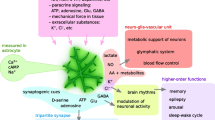Abstract
Electrodes were implanted in the brains of 27 freelymoving rats and the bioelectrical activity of cerebellar cortical structures (lobus simplex, tuber verrais, lobus ansiformis, crus II) and the dentate nucleus was measured simultaneously with the activity of the cerebral cortex and dorsal hippocampus and respiratory rate and motor activity. Different behavioral states were produced by habituation procedures and by elaborating conditional avoidance reflexes to light-flash or click series. In addition, startle reflexes to acoustic stimuli were used to evaluate behavioral state.
The following conclusions could be drawn: 1) in the awake rat the various cerebellar structures have clearly distinguishable bioelectrical activity patterns; 2) changes in these patterns depend on the actual behavioral state of the animal; 3) this dependence upon behavior is especially clear in crus II, one of the projection zones of the tactile and proprioceptive afferent nerves in the cerebellar cortex.
The changes in the electrocerebellogram of the unrestrained rat may be used as an indicator of the behavioral state of the animal.
Similar content being viewed by others
References
Adrian, E. D.: Discharge frequencies in the cerebral and cerebellar cortex.J. Physiol. (London),83: 32P-33P, 1935.
Brookhart, J. M.: The cerebellum.In: Field, J. (ed.):Handbook of Physiology. Section 1, Neurophysiology, Vol.II. Washington, American Physiology Society, 1960, pp. 1245–1280.
Brookhart, J. M., Moruzzi, G., and Snider, R. S.: Origin of cerebellar waves.J. Neurophysiol.,14: 181–190, 1951.
Crepax, P., and Infantellina, F.: L’attività elettrica del lembo isolato di corteccia cerebellare di gatto.Boll. Soc. Ital. Biol. Sper.,31: 1229–1231, 1955.
Crepax, P., and Infantellina, F.: Il preparato di lembo isolato di corteccia cerebellare di gatto.Arch. Sci. Biol. (Bologna),41: 57–73, 1957.
Dow, R. S., and Moruzzi, G.: The Physiology and Pathology of the Cerebellum. Minneapolis, University of Minnesota Press, 1958, 675 pp.
Irger, I. M., Koreischa, L. A., and Tolmasskaja, E. S.: Voprosy nejrochirurgii,5: 34–38, 1949 (Russ.).
Irger, I. M., Koreischa, L. A., and Tolmasskaja, E. S.: (Untersuchungen über die elektrische Aktivität phylogenetisch unterschiedlicher Teile des Kleinhirns beim Menschen und bei Tieren.)Fiziol. Z. SSSR,37: 273–282, 1951 (Russ.).
Klingberg, F., and Pickenhain, L.: Veränderungen des ECG, der kortikalen hervorgerufenen Potentiale und der Startle-Reaktionen bei Ratten während der Ausarbeitung eines bedingten Fluchtreflexes.Acta Biol. Med. German.,12: 552–567, 1964.
Klingberg, F., and Pickenhain, L.: Über die Beteiligung des Hippokampus an der Ausarbeitung eines bedingten Fluchtreflexes bei der Ratte.Acta Physiol. Acad. Sci. Hungar.,27: 359–374, 1965a.
Klingberg, F., and Pickenhain, L.: Elektrophysiologische und Verhaltensuntersuchungen über die Ausarbeitung eines bedingten Abwehrreflexes auf elektrische Reize ohne Fluchtmöglichkeit bei Ratten.Acta Biol. Med. German.,14: 749–763, 1965b.
Klingberg, F., and Pickenhain, L.: Über induzierte Salven im Bulbus olfactorius der Ratte und ihre Beziehung zum Verhalten des Tieres.Acta Biol. Med. German.,15: 58–70, 1965c.
Klingberg, F., and Pickenhain, L.: Das Auftreten kortikaler Nachentladungen als Indikator für den Verhaltenszustand des Tieres.Wiss. Z. Karl-Marx-Univers. Leipzig,15: 533–539, 1966.
Klingberg, F., and Pickenhain, L.: Der Einfluss des Verhaltens auf die photisch ausgelöste Rekrutierung.Acta Biol. Med. German.,19: 267–283, 1967.
Klingberg, F., and Pickenhain, L.: Das Auftreten von “Spindelentladungen” bei der Ratte in Beziehung zum Verhalten.Acta Biol. Med. German.,20: 45–54, 1968.
Klingberg, F., Pickenhain, L., and Gelbrich, D.: Registrierung der Atmung bei der frei beweglichen Ratte im chronischen elektrophysiologischen Experiment.Acta Biol. Med. German.,12: 619–622, 1964.
Klingberg, F., Pickenhain, L., and Sakano, N.: Beziehungen zwischen der motorischen Reaktionsbereitschaft der Ratte und dem Startle-Reflex.Acta Physiol. Acad. Sci. Hungar.,29: 261–266, 1966.
Kullanda, K. M.: (Elektrische Erscheinungen in der Kleinhirnrinde.) in: Sovremennye problemy elektrofiziologičeskich issledovanij nervnoj sistemy. Moscow, 1964, 333–360 (Russ.).
Larsell, O.: The morphogenesis and adult pattern of the lobules and fissures of the cerebellum in the white ratJ. Comp. Neurol.,97: 281–356, 1952.
Lifschitz, W.: Changes in cerebellar electrical activity during the development of conditioned reflexes.J. Physiol., London,159: 29P-30P, 1961.
Pickenhain, L., and Klingberg, F.: Behavioral and electrophysiological changes during avoidance conditioning to light flashes in rat.Electroenceph. Clin. Neurophysiol.,18: 464–476, 1965.
Pickenhain, L., and Klingberg, F.: Charakterisierung unterschiedlicher Stadien des Wachzustandes bei der Ratte durch elektrophysiologische und Verhaltensdaten.Acta Physiol. Acad. Sci. Hungar.,29: 253–260, 1966.
Pickenhain, L., and Klingberg, F.: Hippocampal slow wave activity as a correlate of basic behavioral mechanisms in rat. In: Progress in Brain Research. Vol. 27, Structure and Function of the Limbic System, 1967a, pp. 218–227.
Pickenhain, L., and Klingberg, F.: Electrophysiological and behavioral investigations on the delay period of conditioned reflexes, In: Recent Development of Neurobiology in Hungary. Vol. 1: lissák, K. (ed.): Results in Neuroanatomy, Neurochemistry, Neuropharmacology and Neurophysiology, 1967b, pp. 98–120.
Pickenhain, L., and Klingberg, F.: Hirnmechanismen und Verhalten.In: J. Bures, G. Kostjuk, E. Roy John and L. Pickenhain (Hrg.), Abhandlungen aus dem Gebiet der Hirnforschung und Verhaltensphysiologie, Bd. 2, VEB G. Fischer V. Jena, 1968, 256 pp.
Rétif, J.: Ètude de l’activité électrique spontanée du cervelet humain.Acta Neurol. Psychiat. Belg.,64: 825–831, 1964.
Snider, R. S., and Eldred, E.: Maintenance of spontaneous activity within the cerebellum.Proc. Soc. Exp. Biol. Med.,72: 124–127, 1949.
Szabó, I., Kellényi, L., and Karmos, G.: A simple device for recording movements of unrestrained animals.Acta Physiol. Acad. Sci. Hungar.,26: 343–349, 1965.
Author information
Authors and Affiliations
Additional information
Revision of a paper delivered at the Third Annual Meeting of the Pavlovian Society of North America, Baltimore, Maryland, September 6, 1968.
Rights and permissions
About this article
Cite this article
Oehler, J., Pickenhain, L. & Klingberg, F. The bioelectrical activity of cerebellar structures in the freely-moving rat. Integr. psych. behav. 4, 187–198 (1969). https://doi.org/10.1007/BF02999657
Issue Date:
DOI: https://doi.org/10.1007/BF02999657




